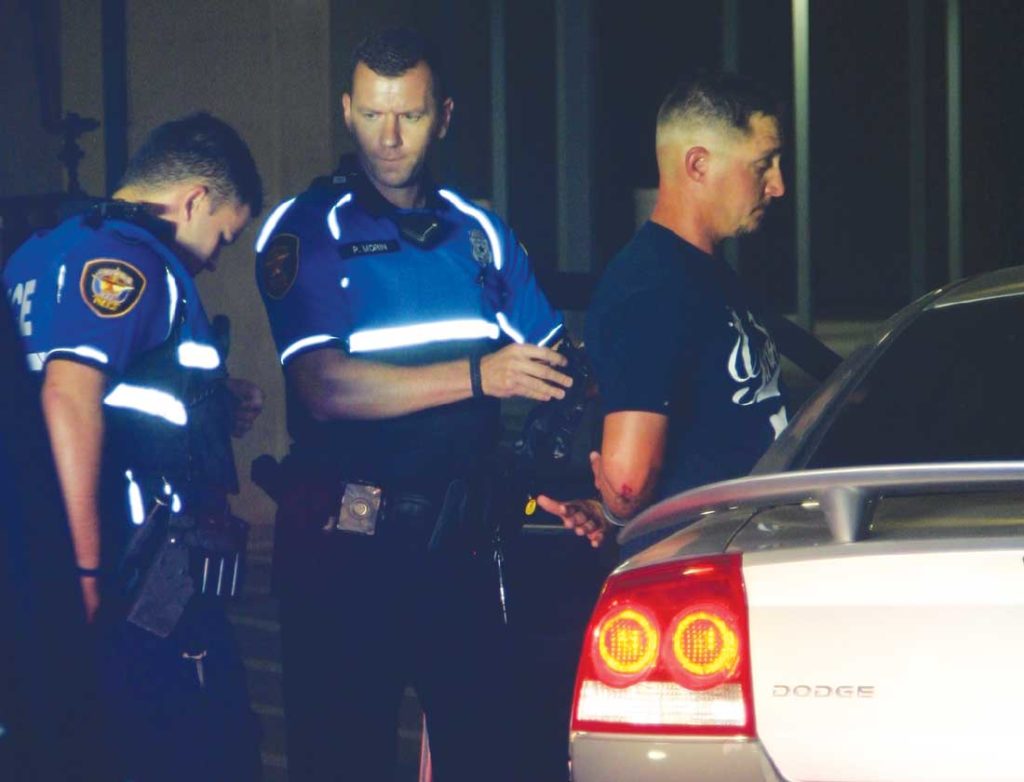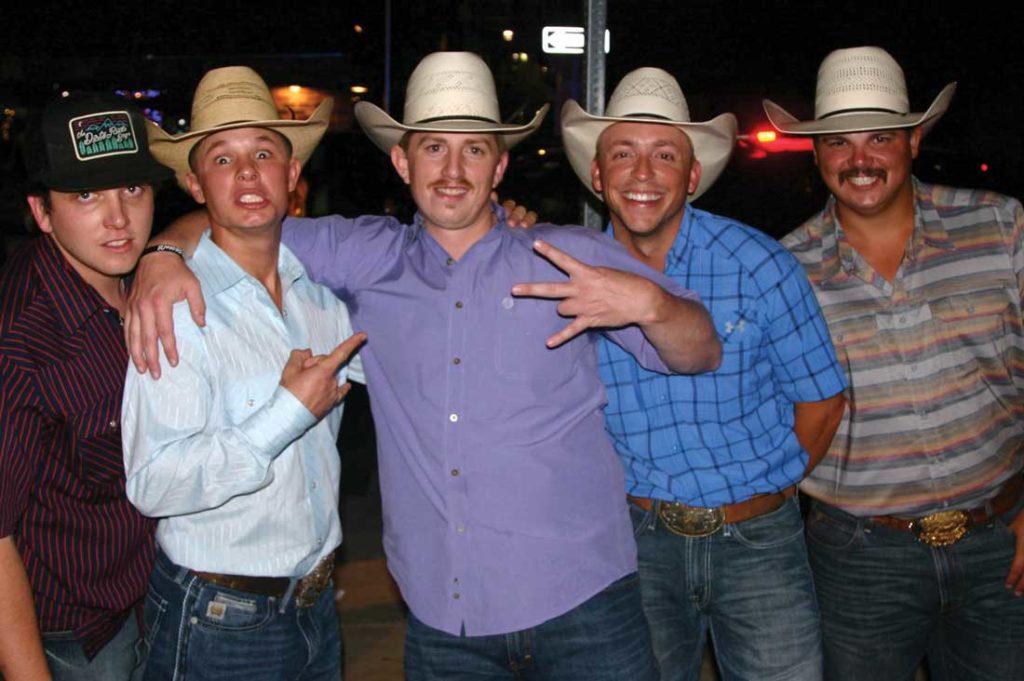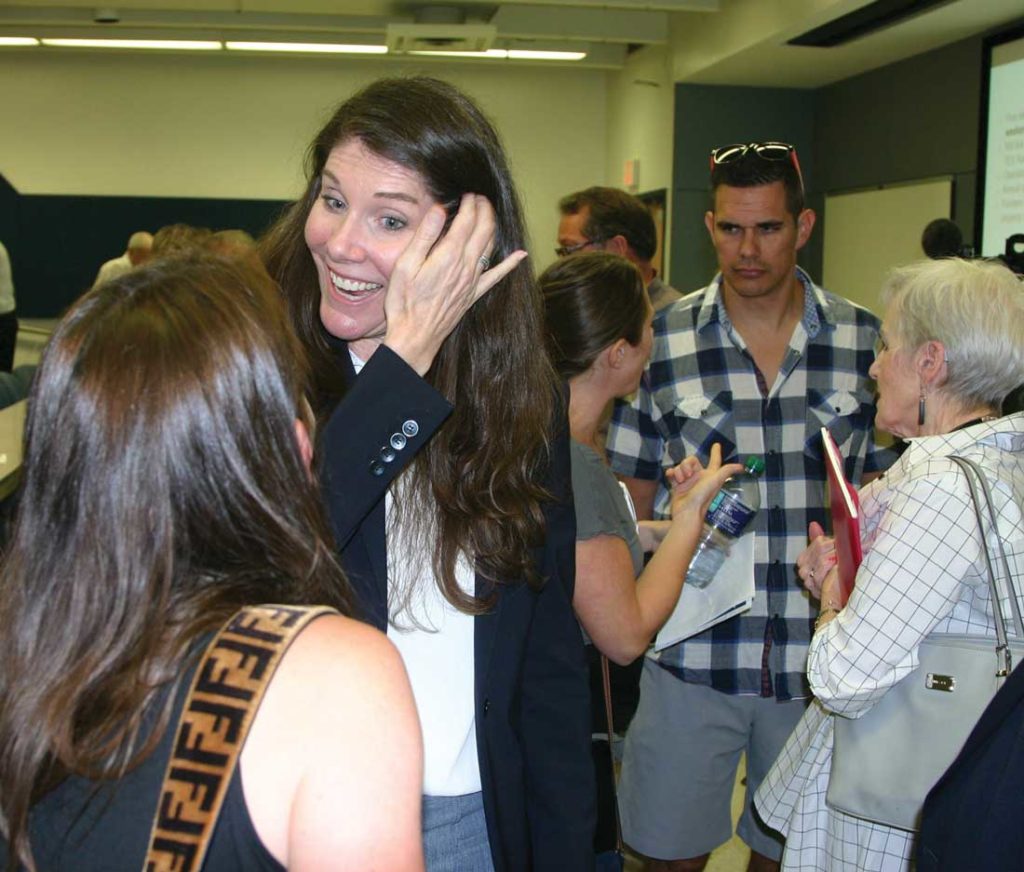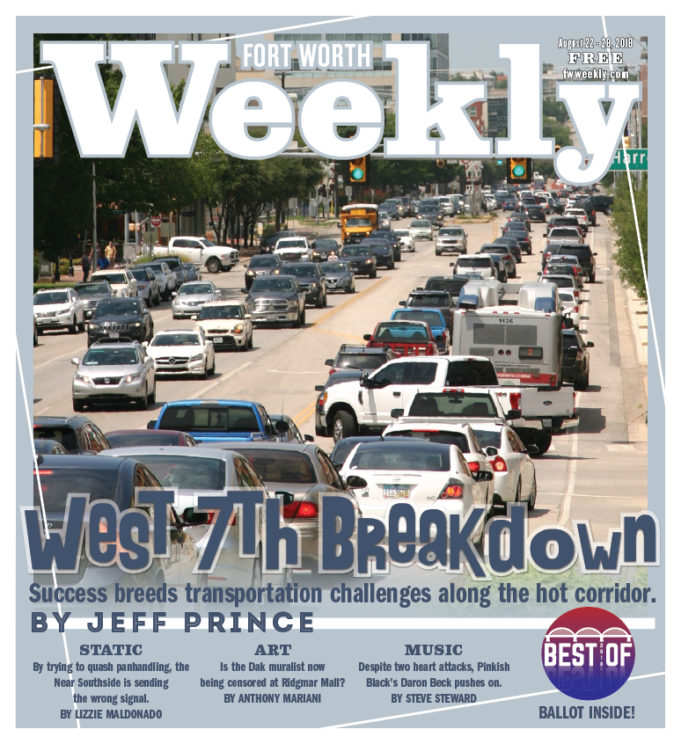The planned $8.5 million redesign of West 7th Street between the decorative bridge and the Cultural District is splitting opinions among city leaders, business owners, and residents.
More bike lanes! No, more car lanes! Wait, we need buses! Let’s combine buses and bike lanes! Are you mad? What about pedestrians – this is an urban village, not a highway! No, it’s the primary road leading in and out of downtown from the West Side, you fool! Times change, pal!
The debates have echoed at City Hall and at public hearings in recent months.
A place where no one was talking about the redesign? West 7th Street party corridor last Friday night. Thousands of mostly young people were tipping their glasses with joyful abandon in the core area bounded by West 7th, Foch Street, West Lancaster Avenue, and University Drive.
I showed up at 11 p.m. and had no trouble finding an empty parking space on the south side of West 7th Street. Despite hearing frequent complaints about the lack of curbside parking, I saw random empty spaces on most of the streets inside the core area, even though crowds were thick. Summer break had ended. College campuses were set to resume classes this week. The kids were back in town and thirsty.
“Welcome Back TCU” was emblazoned on a brightly lit sign at Varsity Tavern, where a long line of people was waiting to get inside.
The day had been hot and muggy, but the evening was cool and pleasant. Most of the bars were packed with youngsters. The over-40 crowd was practically nonexistent.
I walked toward Fred’s Texas Café for a beer and noticed several people gathered around a woman lying on the street near a curb, peering into a sewer drain near the intersection of Currie and Morton streets. Her friend had dropped his Texas A&M University class ring and watched in horror as it rolled into the sewer. He and other friends shone their phone lights into the darkness of the sewer drain to no avail. Strangers stopped to help, trying without success to remove a manhole cover that was bolted down. A police officer rode up on a bike to watch. A patrol car arrived moments later. Then a firetruck. Before long, about a half-dozen cops and firefighters commandeered the scene with tools and flashlights.
Ray Hart of Fort Worth walked up and wondered what all the fuss was about. I told him someone lost a class ring. He questioned using so many public servants on such a frivolous endeavor – until learning the search involved an Aggie ring. Hart attends A&M.
“It’s worth every taxpayer penny!” he said. “Gig ’em!”
The large crowd erupted in cheers after a firefighter removed the manhole and fetched the ring.
“Thank you so much,” the ring’s owner told a police officer.
“You bet,” the cop replied with a smile. “Go, Frogs.”
Fortunes, however, run hot and cold in this scene. Ten minutes later, a Dodge Charger pulled up to the same intersection with a patrol car following behind. The cop flashed his lights. Within minutes, the driver – who climbed out of his car with a bloody elbow and red, sweaty face – was arrested and handcuffed. I don’t know what he had done, but he looked sorrowful. Some of the same police officers who had joked while searching for the Aggie ring helped with the bust.

I wasn’t drinking much since I was researching this story, but by late evening, the youthful, drunken energy had become contagiously intoxicating. I could have easily ditched my notepad and camera and joined in the revelry, even though I’m more of a dive bar kind of guy. West 7th is a homogenized, gleaming, clean, safer version of, say, Dallas’ Deep Ellum. I walked up and down the streets taking photos and meeting people from 11 p.m. to 2 a.m. and never felt unsafe. Police were everywhere. Over on West 7th Street, traffic was light compared to daytime hours.
In July, city officials converted Morton, Bledsoe, Norwood, and Foch streets from two-way to one-way. Now, pedestrians have to look in one direction only for oncoming traffic, which is expected to reduce vehicle-pedestrian conflicts. Farther south, the Farrington Field parking lot offers paid parking, further reducing the need for people to dock their cars alongside busy streets.
At 2 a.m. – closing time for the many bars lining the streets – patrons poured onto the streets, searching for cars or Uber drivers. Some of the inebriated masses crossed from the south side of West 7th Street to the north side in search of restaurants such as In-N-Out Burger. I sat in my car while parked at one of the curbside spaces and watched different groups of people crossing the street in front of oncoming traffic, prompting motorists to brake or honk their horns. Typically, the jaywalkers responded by laughing and yelling.
A half-dozen young men were almost daring cars to hit them.
“I don’t know why all these millennials are wussing out!” one of them yelled inexplicably into the night air.
A man and woman were half carrying, half dragging another young woman who clearly had imbibed too ambitiously. They laid her down on the bus stop bench near the Wendy’s to rest awhile.
A couple walking along the sidewalk were arguing. “Why do you have to be so drunk?” the man said.
“I’m not drunk,” the woman replied, her arms flailing wildly as she turned around to confront him. Then she ran ahead of him.
She saw me sitting in my car beside the street and tried to open my back door. It was locked, but she kept pulling on the handle.
“You don’t know me,” I said through the open window.
“Yes, I do,” she slurred. “You’re the Uber.”
“No, I’m not.”
“Yes, you are.”
Her boyfriend leaned inside my passenger window.
“I’m not the Uber,” I said.
He rolled his eyes and grabbed his girlfriend by the arm. They kept walking.
*****
Earlier that day, I had bummed around West 7th for a few hours and noticed an altogether different vibe. That morning, a weary looking fellow walked slowly on the sidewalk past the variety of retail shops. The midmorning sky was gray and threatened rain. Humidity thickened the air. Weary Guy stopped near a bench and set down the two plastic bags he was carrying. He pulled off his sweaty T-shirt, wadded it up, and tossed it inside a bag. From the other, he pulled out a box of sanitary napkins. Standing near a hair salon’s front entrance, the man gave himself a good wipe-down, starting with his face and neck before moving to his armpits and torso, finishing in grand style by digging into his bellybutton.
Afterward, he sat down and pulled off his sneakers. Wiped them with the sweaty napkins. Put the napkins back in the sack. Donned the shoes. Then, shirtless and refreshed, he continued on his journey toward the downtown skyline about a mile eastward.
Zipping by in the adjacent bike lane was a young man wearing a backpack and pedaling a 10-speed. Cars whizzed by in the five lanes that carry traffic. A bus rumbled to a stop beside a curb to pick up a couple of riders. Occasional shoppers strolled along either side of West 7th carrying newly purchased goods in sacks.
By day, the place feels like a sleepy outdoor mall with a hectic thoroughfare chiseled through it.
At night, the corridor grows thick with people seeking booze, food, fun, and hook-ups at what has become party central in Fort Worth. Some revelers live in the apartments and condos built in this bustling area just west of downtown. Others travel here from far and wide. When it comes to booze sales, Varsity Tavern at the corner of Morton and Norwood streets has occasionally outpaced much larger venues in North Texas such as Billy Bob’s Texas.

Whether you’re a resident, cyclist, commuter, shopper, bus driver, shirtless guy enjoying a makeshift bath on a Wednesday morning, or TCU frat boy scoping out meat markets on a Saturday night, you’ll be impacted by West 7th Street traffic in some way or other
Crossing such a wide street can be difficult and scary, even when using crosswalks and obeying signals. Cars exceed the 35 mph speed limit regularly, except when the street becomes congested. On weekends, people leave bars at closing time, creating brief gridlocks as everyone makes their way toward University, Henderson, or Montgomery streets and on to I-30 or wherever they’re headed.
City officials want to tackle these problems. So do residents.
“All those people that now live, work, [enjoy] recreation, and eat dinner there are seeing intuitively that it’s not comfortable to walk across 7th Street, and they would like to see something happen,” said Ray Boothe, a longtime local architect.
The founder of Boothe Architects has watched the city grow from a drowsy cow town to a major metropolis with a population zeroing in on 1 million. In 2002, he told the Fort Worth Weekly that smart money was being invested along West 7th, whose adjacent businesses were mostly industrial.
Now, 16 years later, the warehouses and blue-collar businesses have been replaced with glitzier retail and residential properties.
“I certainly like all the activity that’s been created,” Boothe said. “It just seemed so obvious with the Cultural District there and all the activity on University, Lancaster, and 7th streets. It was kind of a forgotten area that was primed for somebody to do something with.”
Success has a flipside – congestion, parking shortages, and safety issues. Pleasing everyone when tackling these problems can be difficult if not impossible.
Someone eager to lead the charge is Mayor Betsy Price. Shortly after her election in 2011, she pinpointed West 7th Street as an area she wanted to shape for the future. She chose the project to scrutinize at the Mayor’s Institute on City Design, a leadership initiative of the National Endowment for the Arts in partnership with the United States Conference of Mayors. Since 1986, the Washington, D.C., institute has helped prepare mayors to become urban designers transforming their communities.
“At the time, West 7th was just starting to come to life, and it was the right time for us to think big picture and help shape the vision for the long-term project,” Price told me in a recent email exchange.
Price spent three days at the institute hobnobbing with architects, developers, artists, and other mayors studying and touring similar projects.
“It was a great opportunity to hear and see what other cities were doing to address urban design challenges and learn about best practices we could implement in Fort Worth,” she said. “The West 7th area has gone from being a toddler to an adolescent. It is truly coming into its own, and we are pleased with its direction. We also recognize there are still some growing pains and plenty of opportunity for growth.”
Her thoughts on the $8.5 million redesign might come as sweet relief to many of the residents and entrepreneurs along the thoroughfare.
“Ultimately, feedback from citizens will guide the use of the bond money set aside for the redesign,” she said. “Our hopes would be to prioritize funds to increase connectivity and walkability – a design that is more desirable for pedestrians.”
*****
Residents flocked to the three public hearings held recently to discuss potential right-of-way improvements for West 7th Street. Some people came ready for confrontation, fearing city officials might ignore their input and force bad ideas down their throats.
The bond program is providing money to improve the corridor from the Trinity River west to University Drive for motorists, pedestrians, cyclists, and transit users. Ideas include improving pedestrian crossings, sidewalks, and traffic signals, creating shared bus and bike lanes and mid-block crosswalks, installing landscaping, and building a median in the center of the street. Construction is slated to begin in 2020.
These improvements combined with a new electric bus shuttle –– The Dash –– are hoped to address the problems created by cars and people intermingling in close proximity. The Dash is slated to begin service in 2019.
At the first public hearing regarding West 7th redesign, city Project Manager JoAnne Kamman began by giving a brief overview. Staffers were considering how to best spend the bond money to make the street more friendly for pedestrians and cyclists while still allowing easy access for the approximately 50,000 vehicles relying on the thoroughfare each day.
Kamman was one minute into her spiel before an elderly man raised his hand.
“Can we hold questions until the end?” Kamman said.
The man ignored her.
“We are talking about focusing on walking and bicycling,” he said. “This is not New York. This is not an East Coast city. Frankly, I strongly object to the spending of my taxpayer money to take away vehicular traffic lanes for bicycle lanes.”
“This is all about balancing things,” Kamman said.
“Who made that decision?” the man said, his voice rising. “How was that developed?”
Cyclists don’t pay gas or road taxes or license fees, he said.
“I don’t see a need to take away vehicular traffic lanes,” he went on. “You are spending money that should be used to make better roads, not bicycle paths.”
An impromptu debate broke out. Many people in the room wanted better bike lanes and public transit to reduce the number of cars. Some wanted more street-side parking. Others want no street parking.
Kamman shushed the crowd.
“We want to make this as safe as we can,” she said.
Currently, West 7th Street contains four traffic lanes (two in each direction) with a center turning lane and no median. Both sides of the street include a 3-foot bike lane for cyclists.
Someone commented that cyclists are rarely seen in the bike lanes, and buses come upon empty bus stops more often than not. Kamman described a chicken-and-egg situation.
“We have heard from a lot of people, who said, ‘If you can get a really nice bike lane going through there, we will ride it,’ ” Kamman said.
Many in the crowd hooted in disbelief. They expressed apprehension, realizing that city officials held the power. The redesign plan doesn’t require city council approval.
Phillip Poole, an urban planning consultant with his real estate development firm TownSite Co., spoke from the crowd, saying West 7th has become “a pedestrian area.”
A five-lane busy street carrying large volumes of traffic is no longer suitable, he said.
“This could be a grand boulevard,” he said. “What we’re getting is a thoroughfare. I don’t believe any one of us want that to occur.”
Investors and developers built a magnificent collection of retail, housing, and entertainment venues, he said, and the city isn’t doing enough to make that kind of development thrive.
“We’ve built this area, and we have a lot of people living on one side of 7th Street wanting to go shopping on the other side of it, and they need refuge and dedicated crossings,” he said. “This is an opportunity for us to do something right.”
Much of daily (and nightly) activity takes place on the south side of the street. However, numerous upscale apartments have been built along the north side, along with Montgomery Plaza, Target, and various eateries. And bars, such as Lola’s Saloon, on the north side of the street catch customers leaving downtown at the end of the workday because it is easier to make a right into a bar parking lot than try to take a left across traffic. Poole wants to better connect both sides.
Some crowd members discussed how similar projects on West Magnolia Avenue and Rosedale, Main, Berry, and Race streets have proven more successful at combining roadways and pedestrians. Meanwhile, West 7th has become more congested than ever.
Someone mentioned how the slow progress on building bridges for the Panther Island downtown urban lake development has shut down traffic on nearby White Settlement Road. The construction project is years behind schedule with no announced end date. Now, most of that White Settlement traffic relies on West 7th.
“We’ve got all this traffic basically brought here, because we’ve cut off the other routes east-west,” Poole said.
Clearly, people in attendance didn’t agree on the specifics of a redesign. A woman said she had cycled in shared bike and bus lanes in other cities without a problem, but another expressed doubt: “I would never bike in the same lane as a bus.”
A man said he owned a business facing West 7th and believed he would lose customers if the approximately 50 parking spaces available on the south side of the street were removed to widen the road. Another guy disputed that assertion, saying curbside parking spaces rarely saw turnover during the day because area employees parked in those spaces and kept their vehicles there all day. (I’ve been watching those spaces in recent weeks. Turnover is slow, but I usually see an empty space or two whenever I drive by.)
Most people at the public hearing said city plans downplay the importance of foot traffic.
“You made buses and cars the priority,” someone said.
The crowd began to murmur. Someone asked whether the public hearings were just a dog-and-pony show. Kamman assured everyone that city officials were listening, but the crowd grew louder and more defiant.
Finally, Ann Zadeh interjected. The Fort Worth City Councilmember whose District 9 includes the West 7th corridor, she had been standing off to the side of the meeting room at the UNT Health Science Center, listening to people express their frustrations. She faced the crowd and told them that city officials were interested in their opinions, evidenced by the public hearing, walking audits, and other polling measures taken. She told them that the bond election to fund the street’s redesign had been approved by voters and was going to happen.
“Whether it’s good or not?” someone asked. “What everyone’s wondering here is, are we talking to a wall?”

“You’re not talking to a wall,” Zadeh said. “The proposals tonight were adjusted because of input that was received. Some of the first designs didn’t include keeping on-street parking, and even sitting here listening tonight to the input we’re receiving, it’s absolutely impossible to do all the things everyone is asking.”
She spoke with firm resolve, looking audience members in the eyes but without raising her voice.
“The same speakers have contradicted themselves in what they’ve asked for in some of the comments, saying they want the on-street parking and saying they want that [space] available for other things,” she said. “You see the struggle that we face here. Not everybody agrees on what we need to try to fit into that corridor. There is no way to come to a total consensus where everyone agrees on what the final design will be.”
*****
If you were to personify West 7th Street, you might see pimples, a mouthful of braces, and gangly elbows and knees.
“It’s a district that is going through a kind of puberty,” said Assistant City Manager Fernando Costa. “It’s transforming from its former industrial character to mixed-use and everything associated with it. That’s a major thing with a lot of growing pains.”
Puberty can be a difficult stage for humans or streets.
“It is in some ways one of the most difficult stages of life,” he said. “You are going through an identity crisis. You are trying to understand who you are and who you’re going to become.”
City planners adhere to a “complete streets” policy that incorporates multiple transportation modes: automobiles, transit, cyclists, and pedestrians.
“Usually in Fort Worth, we find ourselves in vigorous debates between people who might call themselves urbanists and people who might prefer a more suburban lifestyle,” Costa said. “In the case of West 7th, it’s a debate among urbanists. There is broad agreement about the importance of developing a walkable mixed-use urban village, but there is a difference of opinion about the means to achieve that end. That makes this debate about the design of West 7th somewhat different from most debates that we encounter in Fort Worth.”
City leaders might express enthusiasm for a pedestrian-friendly atmosphere but not at the exclusion of other modes of transportation. Currently, the bike lanes seldom see cyclists, and the buses sometimes run empty. That will change only when policies push for change, Costa said.
History has proven city leaders to be slow to embrace transit, bicycles, and pedestrians. Texas cities as a whole are typically abysmal when rated for walkability. Big cities up north and on the West coast are far more pedestrian-friendly than in Texas, according to WalkScore.com, a real estate website that calculates the walkable nature of cities. Fort Worth is ranked among the worst of the big Texas cities. We don’t fare much better with public transit.
“Many of our civic leaders understand that we need to give transit much higher priority than we’ve given it historically if Fort Worth is to become economically more competitive with other big cities around the country and the world,” Costa said. “Our transit system is not what it could be and not what you might find in other cities that are appealing to young professionals and others we are trying to attract.”
Last Friday, a middle-aged woman sat at the bus stop near the Wendy’s. The day was sunny and sweaty. She didn’t mind. The bus runs every 15 minutes. She wouldn’t wait long. Janet Jackson – yep, that’s her name – said she’s been riding this bus route regularly for 20 years, ever since she moved to Fort Worth in 1997 and began working near West 7th.
“The bus is so much easier” than driving a car, she said, speaking loudly to be heard over the din of passing traffic. “I’m originally from Chicago. Transit is big there. We use transit for everything. Fort Worth is growing. More and more people are coming here, and there is a lot of congestion. Why not allow pedestrians to utilize the street? All the cars zipping by really take away from this.”
She recalled how West 7th was “run down” all those years ago.
“I watched all of this being built,” she said. “They’ve really done an awesome job and built this place up fabulously. None of this was here except Wendy’s.”
She stays away from the area at night.
“It’s like a city unto itself,” she said. “Let the young people live it up.”
What’s needed is something like San Francisco’s trolley system running up and down the street, she said. (The bench she was sitting on at the bus stop would be the landing spot 12 hours later for the drunken young woman I would watch being carried by friends after the bars closed.)
Beginning next year, five electric transit buses are expected to be running at 15-minute intervals up and down West 7th Street, shuttling people between downtown and the Cultural District 12 hours a day or more. In the short term, ridership on The Dash might struggle. Texans are anchored to their cars. Most drivers want to find a parking space within spitting distance of wherever they’re heading. Changing that mentality takes time and commitment from city leaders, Costa said.
“Are we going to leave that outside lane for buses and cyclists while people are stuck in traffic in the other two lanes, watching the outside lanes staying empty except for a bus every 15 minutes?” Costa said.
Boothe believes the city will benefit in the long run if it remains firm on its complete street philosophy.
“Fifteen years ago, most city planners – and for that matter, almost anybody – still felt that streets were for cars and sidewalks were for people, and people needed to stay out of the way of the cars,” he said. “We’ve transitioned some now. We have bike lanes and pedestrian crosswalks. They’re putting up signs that say if there are pedestrians in the crosswalk, they have the right of way, not the car. Those are all good things. It’s fairly new thinking in the area of urban design.”
That doesn’t mean tearing out the street.
“West 7th has always been a major thoroughfare for the city,” Boothe said. “In my way of thinking, it can be mitigated by some of the things we’ve been talking about, but turning it into a pedestrian mall makes no sense at all.”
The key, city leaders say, is creating transit and cycling options that are as appealing as riding automobiles. Until that happens, why would residents abandon their cars?
“It is important for us to assign higher priority to transit and other transportation modes than we have in the past,” Costa said.
West 7th redesign plans mean hunks of steel and rubber will have to co-exist more effortlessly with other modes of transportation. Adding bus/bike shared lanes, curbside parking, and a landscaped median will reduce the amount of lanes available for cars.
Running adjacent to West 7th but a little farther south is West Lancaster Avenue, a relatively under-utilized roadway between downtown and the Cultural District. Changes on West 7th might push motorists toward Lancaster, easing congestion on West 7th, and since work on the redesign won’t begin for two years, maybe the Panther Island bridges will be completed by then, opening up White Settlement for even more spillover traffic from 7th.
“We have the ability to reconfigure West 7th without too much fear that in doing so we’re going to choke traffic that wants to move between downtown and the museums,” Costa said. “The three thoroughfares together – White Settlement, 7th, and Lancaster – would provide more than enough capacity to carry traffic between downtown and the Cultural District.”
Anyone who thinks city officials are scrambling to react to the explosion of growth on West 7th is missing the big picture. A master plan dating back decades called for the creation of urban villages along West 7th and other streets. Some, like Magnolia Avenue, are thriving. Others, such as Race and South Main streets, are coming to life.
Precise planning doesn’t mean the rollout will be easy. Growing pains hurt.
“It’s hard to believe, but 20 years ago, many of our civic leaders were troubled about the decline of central city commercial districts like West 7th, Belknap, Race, Magnolia, South Main, Camp Bowie,” Costa said. “How we could bring them back to life? We are doing that in dramatic form.”
The impetus for urban villages can be traced back almost 40 years to when the wealthy Bass family staged a turnaround in downtown by establishing the massive mixed-use Sundance Square area. That push has continued to spread to areas all around the central city.
“We’re now going through the issues that naturally arise as you undergo this kind of dramatic transformation,” Costa said. “These issues are highly predictable. I could have told you 20 years ago that some of these issues were going to arise because we are changing. Change requires adjustment, and it never comes easily. But nothing is going to get better unless we change things, and people have told us they want things to get better.”
Contact Jeff at jeff.prince@fwweekly.com.













I lived on West 7th across from Montgomery Plaza from December 2006 through April 2017. It ceased to be “cool” and became over developed in the last few years. The thousands of people who live in that small area are still going to need to commute back and forth to wherever they work. There are not enough jobs along West 7th, or downtown for that matter, to support the number of residential units in that area. Cars are not going away, and traffic will only keep increasing because the City has allowed it to develop too densely.
There is nothing wrong with the existing bike lanes along West 7th. I used them quite frequently myself to get back and forth to Trinity Park and the trails. You can easily get downtown on a bike from West 7th. It’s also easy to ride over to the TCU area on a bike from there. The bike friendliness of West 7th should not be a complaint. The lack of respect between motorists and cyclists is the problem.
Trying to cross West 7th as a pedestrian is a nightmare. But the Carroll/West 7th intersection was the worst for pedestrians, and it is much improved since they moved the cross walk on the east side of Carroll to the west side. The main problem now for pedestrians in the area, is no legal cross walk between Carroll and Stayton, which makes it tough for people in the condos and townhomes off of Stayton to safely walk to Montgomery Plaza.
The same thing is happening now in the near South Side, although it is generally still in the “cool” stage for now. But it is getting more densely developed by the day as well.
Race Street is still kind of scary at night. That area has a long way to go yet before it is anything like West 7th or the near South Side, and maybe that is a good thing.
By the way, in addition to the Wendy’s, Fred’s was there before the “boom” as was La Familia, although they moved from 7th to Foch.
I decided last night to cruise through the West 7th District of Fort Worth. In years past it was all warehouses, now it’s the FW version of Deep Ellum.
What I saw cemented why I don’t go there anymore. At least 4 PD Ticket-masters slapping $25 fines on cars parked along streets, tow trucks hauling off vehicles to a nearby flatbed/autohauler and then a guy in front of me made a wrong turn and the police were on him like flies on honey.
I’m all for safety, but what is the message we are sending? Come spend money here, but we will bust your ass if you spit on the sidewalk? I just don’t get it. If I ever received a $400 tow, that would be the last time I visited.
It would be really interesting to see how much money is coming into City coffers from the West 7th area, DWI’s, Tickets, tows along with how many arrests occur on a weekend. I bet people would be shocked.
Luckily for me, I can walk there and don’t have to worry about the fines, the tows or the reindeer games, a lot of people can’t. It just seems to me the City is shooting it’s self in the foot with all the ‘enforcement’ of the area. I don’t recall that attitude with Sundance Square.